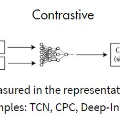Recently, using different channels to model social semantic information, and using self-supervised learning tasks to maintain the characteristics of each channel when fusing the information, which has been proven to be a very promising work. However, how to deeply dig out the relationship between different channels and make full use of it while maintaining the uniqueness of each channel is a problem that has not been well studied and resolved in this field. Under such circumstances, this paper explores and verifies the deficiency of directly constructing contrastive learning tasks on different channels with practical experiments and proposes the scheme of interactive modeling and matching representation across different channels. This is the first attempt in the field of recommender systems, we believe the insight of this paper is inspirational to future self-supervised learning research based on multi-channel information. To solve this problem, we propose a cross-channel matching representation model based on attentive interaction, which realizes efficient modeling of the relationship between cross-channel information. Based on this, we also proposed a hierarchical self-supervised learning model, which realized two levels of self-supervised learning within and between channels and improved the ability of self-supervised tasks to autonomously mine different levels of potential information. We have conducted abundant experiments, and many experimental metrics on multiple public data sets show that the method proposed in this paper has a significant improvement compared with the state-of-the-art methods, no matter in the general or cold-start scenario. And in the experiment of model variant analysis, the benefits of the cross-channel matching representation model and the hierarchical self-supervised model proposed in this paper are also fully verified.
翻译:最近,利用不同渠道来模拟社会语义信息,并利用自我监督的学习任务来保持每个渠道在收集信息时的特征,这已证明是一个非常有希望的工作。然而,如何深入挖掘不同渠道之间的关系并充分利用这一关系,同时保持每个渠道的独特性,是尚未在这一领域很好研究和解决的一个问题。在这种情况下,本文件探索并核实了在不同渠道直接构建对比学习任务的缺陷,并进行了实际实验,并提出了在不同渠道进行互动的层次模拟和匹配代表模式。这是推荐者系统领域首次尝试,我们认为本文件的洞察力对未来基于多渠道信息进行自我监督的学习研究很有启发性。为解决这一问题,我们提议了一个跨渠道匹配代表模式,以关注互动为基础,实现跨渠道信息之间关系的高效建模。基于此,我们还提议了一个等级的自我监督学习模式,并提出了在不同渠道和不同渠道之间进行自我监督的互动式自我学习计划。 在多渠道进行自我监督的实验中,我们提出了大量自我监督的模型, 并且改进了在多层次的实验模型中,我们提出了大量进行自我监督的模型。



